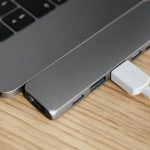To connect multiple monitors with a USB hub, first, make sure your hub is powered and plugged into your computer. Then, connect each monitor using the appropriate cables. Turn on the monitors and select the right input source. Your computer should recognize them. Next, adjust display settings by arranging monitors and configuring resolutions for each. If you hit any snags, there are easy fixes for common issues that you can explore.
Table of Contents
Key Takeaways
- Ensure the USB hub is powered and connected to your computer before adding monitors.
- Use appropriate cables to connect each monitor to the USB hub.
- Turn on the monitors and select the correct input source for each.
- Access "Display settings" to arrange monitors and adjust resolutions as needed.
- Confirm that the computer recognizes all monitors and troubleshoot any connection issues.
Understanding the Basics of USB Hubs
USB hubs are essential tools that expand your connectivity options when connecting multiple monitors. They allow you to connect several USB devices simultaneously, which is particularly useful when your computer has limited ports. By plugging a USB hub into a single USB port, you can easily connect monitors, keyboards, and other peripherals without constantly swapping cables.
Understanding how USB hubs work is vital. They function by splitting a single USB connection into multiple ports, providing flexibility in your setup.
Make sure you choose a powered hub if you're connecting devices that require more power. With the right USB hub, you can enhance your productivity and streamline your workspace, making it easier to manage multiple displays efficiently.
Choosing the Right USB Hub for Multiple Monitors
When selecting the right hub for connecting multiple monitors, you need to consider several factors to ensure optimal performance.
First, check the hub's compatibility with your operating system and monitor specifications. Look for a hub that supports the resolution and refresh rate you need, as not all hubs can handle high-definition displays.
Additionally, consider the number of ports; a hub with multiple ports will allow for easy connectivity. Ensure it has enough power to support all connected devices, especially if you're using powered monitors.
Lastly, look for USB hubs that support USB 3.0 or higher for faster data transfer speeds. Taking these factors into account will help you choose the best hub for your multi-monitor setup.
Step-by-Step Guide to Connecting Your Monitors
Connecting multiple monitors can significantly enhance your productivity and multitasking capabilities. Follow these steps to get started:
- Ensure your USB hub is powered and connected to your computer.
- Plug each monitor into the USB hub using the appropriate cables.
- Turn on the monitors and ensure they're set to the correct input source.
- Check that your computer recognizes the monitors.
Here's a quick reference table for the connection process:
| Step | Action | Notes |
|---|---|---|
| 1 | Connect USB hub | Use a powered hub if needed. |
| 2 | Plug in monitors | Use HDMI, DisplayPort, etc. |
| 3 | Turn on monitors | Confirm input source selected. |
| 4 | Check computer detection | Ensure all monitors are recognized. |
| 5 | Adjust physical setup | Arrange monitors to your liking. |
Configuring Display Settings for Optimal Performance
To maximize your productivity with multiple monitors, it's crucial to configure the display settings properly.
Start by right-clicking on your desktop and selecting "Display settings." Here, you can arrange your monitors to match their physical layout. Drag and drop the monitor icons into the desired position.
Next, adjust the resolution for each display to ensure clarity; typically, you'll want to set them to their native resolutions for optimal performance.
Don't forget to tweak the scaling options if text appears too small or too large.
Finally, select your primary display, which will house your taskbar and main applications.
With these settings configured, you'll create a seamless and efficient multi-monitor workspace tailored to your needs.
Troubleshooting Common Issues With Multiple Monitors
Despite your best efforts at setting up multiple monitors, you might encounter some common issues that can disrupt your workflow.
Setting up multiple monitors can enhance productivity, but be prepared for potential issues that may arise.
Here are a few problems you may face:
- Display not detected: Sometimes, your computer won't recognize one or more monitors. Check connections or restart your device.
- Resolution mismatches: If the displays aren't showing the same resolution, it can lead to clutter. Adjust the settings in your display options to match.
- Flickering screens: This can be due to a loose cable or incorrect refresh rates. Ensure all cables are secure and adjust the refresh rate in the settings.
Frequently Asked Questions
Can I Use Different Monitor Brands With a USB Hub?
Yes, you can use different monitor brands together. As long as your USB hub supports the required connections and resolutions, it shouldn't matter which brands you choose. Just ensure compatibility with your devices for optimal performance.
Will a USB Hub Affect My Computer's Performance?
Yes, a USB hub can affect your computer's performance, especially if it's overloaded with devices. You might notice slower data transfer speeds or reduced responsiveness, so ensure your hub meets your needs without overwhelming your system.
How Many Monitors Can a Single USB Hub Support?
A single USB hub can typically support up to four monitors, depending on the hub's specifications and your computer's capabilities. Make sure to check the hub's documentation to confirm the maximum number of supported displays.
Do I Need Special Cables for Each Monitor?
You won't necessarily need special cables for each monitor, but using the right type ensures compatibility. Check your monitors' requirements and the hub specifications to avoid any connection issues that could arise.
Can I Connect Monitors of Different Resolutions?
Yes, you can connect monitors of different resolutions. Your computer will adapt to the highest resolution supported among them, but the display quality may vary. Just ensure your graphics card supports multiple displays effectively.




